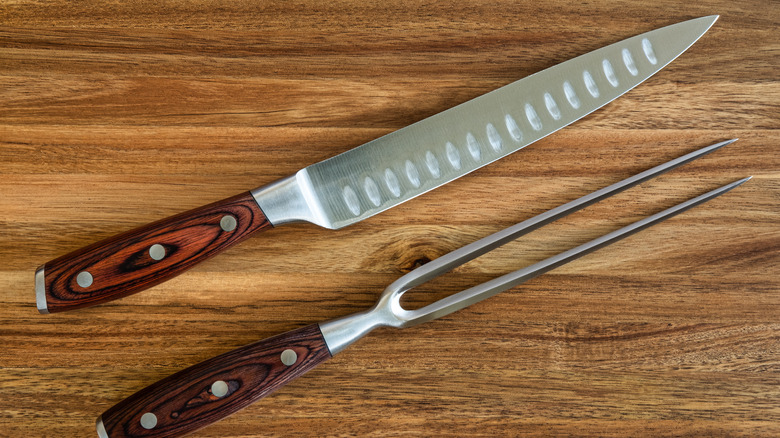The Best Knife For Slicing Meat, According To Geoffrey Zakarian
The hallmark of a skilled chef can be seen and heard in the rhythm created by the lightning-fast, precision cutting of food, alla "Julie and Julia." With enough practice, home cooks can master that skill (and still keep all their digits) using the proper knife with a sharp blade. Knives are an investment, and they can be pricy, but knives are meant to last. A quality knife, balanced in your hand and razor-sharp, can efficiently and quickly prep meals, a task appreciated by even the most begrudged chef.
There are dozens of varieties of knives, differentiated in part by the blade's length, width, serrated or straight edge, thickness of the steel, type of handle (wooden, plastic, rubber, and composite), blade material (high-carbon steel, stainless steel, plastic, and ceramic), and overall comfort and aesthetics. While there are knives available at every price point, it comes down to what you can afford and what feels good in your hand when picking the right knife for you.
According to Food Network, three knives can perform most of the cutting in the kitchen, handling the daily chopping, slicing, and dicing. Every kitchen should have a chef's, serrated bread, and a paring knife to begin, adding more pieces as you expand your culinary techniques. For Sunday roasts and the ceremonial slicing of the Thanksgiving turkey, you may want to make room in your wooden knife block for one more blade, and celebrity chef Geoffrey Zakarian explains which style works best.
Carving knives
According to The New York Times, the country of origin affects the formula of the steel alloy used for high-carbon steel knives. Typically, German knives contain less carbon in the steel, making them softer on the Rockwell C scale than Japanese knives but less brittle. These details affect the knife's weight, shock absorption, how long the knife stays sharp, and ability to corrode.
When slicing meat, especially large roasts, Geoffrey Zakarian reaches for a carving knife, per WFLA. Similar to a slicing knife with a rounded tip, the carving knife is typically 8 to 12 inches long with a sharp point at the end, allowing you to carve around the bone, not wasting any meat. The long thin blade is flexible enough to follow the shape of the meat (per Food Network). Zakarian's carving knife has dimples or cullens along the blade. These hollowed-out oval-shaped scallops allow a pocket of air between the blade and the food, which prevents the knife's surface from sticking to the food, reducing drag and allowing you to slice the meat in a single pass.
Western-style Santoku knives feature cullens as well. The Japanese-style knife, often used in place of a French-style chef's knife, features a "sheep's foot," a flat blade with the tip of the knife curving downward. A chef's knife has a wide, curved blade designed for the repetitive rocking motion used when chopping. Chef's knives are typically 6 to 10 inches long, while Santoku knives are smaller, between 5 and 7 inches (per Saveur).

